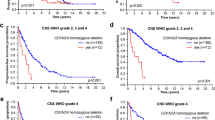Abstract
Purpose
Neuroblastoma (NBL) is a tumor from neural crest cells, and is the most frequent solid tumor in children. Midkine (MK) is a pleiotropin analogon, which is frequently expressed in neuronal and epithelial tumors and is a marker for a poor clinical outcome. The aims of this study were to assess MK expression in NBL and investigate the correlation with clinical outcome.
Methods
Fifty-six specimens of NBL were stained for MK on a tissue microarray by immunohistochemistry (IHC). Fresh frozen tumor tissues were used for RNA isolation, and RT-PCR analysis for MK-mRNA expression was performed. Survival data, risk factors and disease stages were correlated with MK status assessed by IHC and RT-PCR analysis.
Results
MK-mRNA expression was found in the majority of the tumor tissues (75%), whereas MK protein could be detected only in 46% of the NBL by IHC. No correlation of MK status with survival, risk factors or disease stage was observed.
Conclusion
A majority of NBL express MK-mRNA, whereas not all MK mRNA positive tumors showed also a positive MK IHC staining. The high expression of MK-mRNA expression might present a promising target for new adenovirus-based gene therapeutic approaches for the treatment of NBL.


Similar content being viewed by others
References
Weinstein JL, Katzenstein HM, Cohn SL (2003) Advances in the diagnosis and treatment of neuroblastoma. Oncologist 8:278–292
Evans AE, Gerson J, Schnaufer L (1976) Spontaneous regression of neuroblastoma. Natl Cancer Inst Monogr 44:49–54
Haas D, Albin AR, Miller C (1988) Complete pathologic maturation and regression of IVS neuroblastoma without treatment. Cancer 62:818–825
Matthay KK, Villablanca JG, Seeger RC, Stram DO, Harris RE, Ramsay NK, Swift P, Shimada H, Black CT, Brodeur GM, Gerbing RB, Reynolds CP (1999) Treatment of high risk neuroblastoma with intensive chemotherapy, radiotherapy, autologous bone marrow transplantation, and 13-cis-retinoic acid. NEJM 341:1165–1173
Brodeur GM, Pritchard J, Berthold F, Carlsen NL, Castel V, Castelberry RP, De Bernardi B, Evans AE, Favrot M, Hedborg F (1993) Revisions of the international criteria for neuroblastoma diagnosis, staging, and response to treatment. J Clin Oncol 11:1466–1477
Evans AE, D’Angio GJ, Propert K, Anderson J, Hann HW (1987) Prognostic factors in neuroblastoma. Cancer 59:1853–1859
Shimada H, Ambros IM, Dehner LP, Hata J, Joshi VV, Roald B, Stram DO, Gerbing RB, Lukens JN, Matthay KK, Castleberry RP et al (1999) The international neuroblastoma pathology classification. Cancer 86:364–372
Riley RD, Heney D, Jones DR, Sutton AJ, Lambert PC, Abrams KR, Young B, Wailoo AJ, Burchill SA (2004) A systematic review of molecular and biological markers in neuroblastoma. Clin Cancer Res 10:4–12
Fidler IJ (1992) Critical determinants of metastasis. Semin Cancer Biol 12:89–96
Kadomatsu K, Muramatsu T (2004) Midkine and pleiotropin in neural development and cancer. Cancer Lett 204:127–143
Muramatsu T (2002) Midkine and pleiotropin: two related proteins involved in development, survival, inflammation and tumorigenesis. J Biochem (Tokyo) 132:359–371
Owada K, Sanjo N, Kobayashi T, Mizusawa H, Muramatsu H, Muramatsu T, Michikawa M (1999) Midkine inhibits caspase-dependent apoptosis via the activation of mitogen-activated protein kinase and phosphatidylinositol 3-kinase in cultured neurons. J Neurochem 73:2084–2092
Shimada H, Nabeya Y, Okazumi S, Matsubara H, Kadomatsu K, Muramatsu T, Ikematsu S, Sakuma S, Ochiai T (2003) Increased serum midkine concentration is a possible tumor marker in patients with superficial esophageal cancer. Ocol Rep 10:411–414
Obata Y, Kikuchi S, Lin Y, Yagyu K, Muramatsu T, Kumai H (2005) Serum midkine concentrations and gastric cancer. Cancer Sci 96:1792–1797
Ye C, Qi M, Fan QW, Ito K, Akiyama S, Kasai Y, Matsuyama M, Muramatsu T, Kadomatsu K (1999) Expression of midkine in early stage of carcinogenesis in human colorectal cancer. Br J Cancer 79:179–184
Friedrich C, Holtkamp N, Cinatl J Jr, Sakuma S, Mautner VF, Wellmann S, Michaelis M, Henze G, Kurtz A, Driever PH (2005) Overexpression of midkine in malignant peripheral nerve sheath tumor cells inhibits apoptosis and increases andiogenic potency. Int J Oncol 27:1433–1440
Adachi Y, Reynolds PN, Yamamoto M, Wang M, Takayama K, Matsubara S, Muramatsu T, Curiel DT (2001) A midkine promotor-based conditionally replicative adenovirus for treatment of pediatric solid tumors and bone marrow purging. Cancer Res 61:7882–7888
Nakagawara A, Milbrandt J, Muramatsu T, Deuel TF, Zhao H, Cnaan A, Brodeur GM (1995) Differential expression of pleiotropin and midkine in advanced neuroblastomas. Cancer Res 55:1792–1797
Ikematsu S, Nakagawara A, Nakamura Y, Sakuma S, Wakai K, Muramatsu T, Kadomatsu K (2003) Correlation of elevated level of blood midkine with poor prognostic factors of human neuroblastoma. Br J Cancer 88:1522–1526
Muramatsu H, Shirahama H, Yonezawa S, Maruta H, Muramatsu T (1993) Midkine, a retinoic acid-inducible growth/differentiation factor: immunochemical evidence for the function and distribution. Dev Biol 159:392–402
Aridome K, Takao S, Kaname T, Kadomatsu K, Natsugoe S, Kijima F, Aikou T, Muramatsu T (1998) Truncated midkine as a marker of diagnosis and detection of nodal metastases in gastrointestinal carcinomas. Br J Cancer 78:472–477
Acknowledgments
The authors would like to thank Mrs. Beate Roth, the medical student Mrs. E. Varol and Mrs. A. Krickhahn, Dept. Pediatric Surgery, Universitätsklinikum Hamburg-Eppendorf, and Mr. A. Looft, Dept. Pediatric Hematology and Oncology, Universitätsklinikum Hamburg-Eppendorf for technical assistance.
Author information
Authors and Affiliations
Corresponding author
Rights and permissions
About this article
Cite this article
Fiegel, H.C., Kaifi, J.T., Wachowiak, R. et al. Midkine is highly expressed in neuroblastoma tissues. Pediatr Surg Int 24, 1355–1359 (2008). https://doi.org/10.1007/s00383-008-2263-0
Published:
Issue Date:
DOI: https://doi.org/10.1007/s00383-008-2263-0




